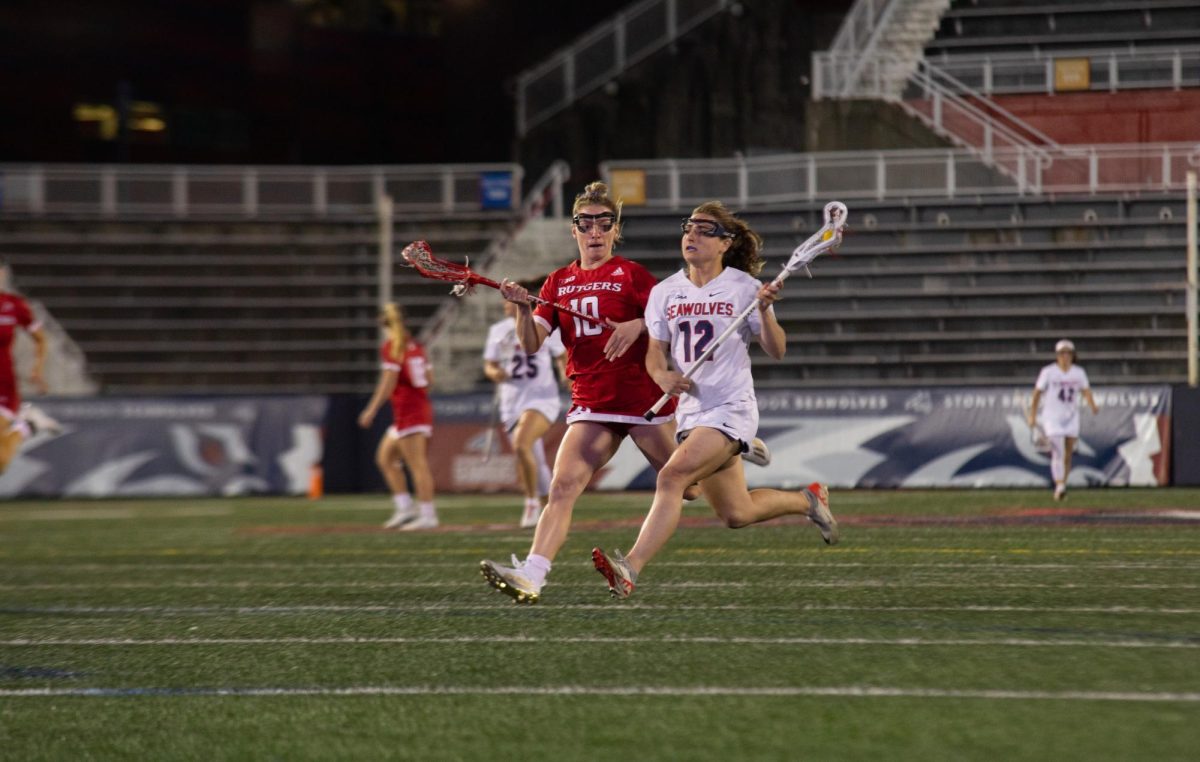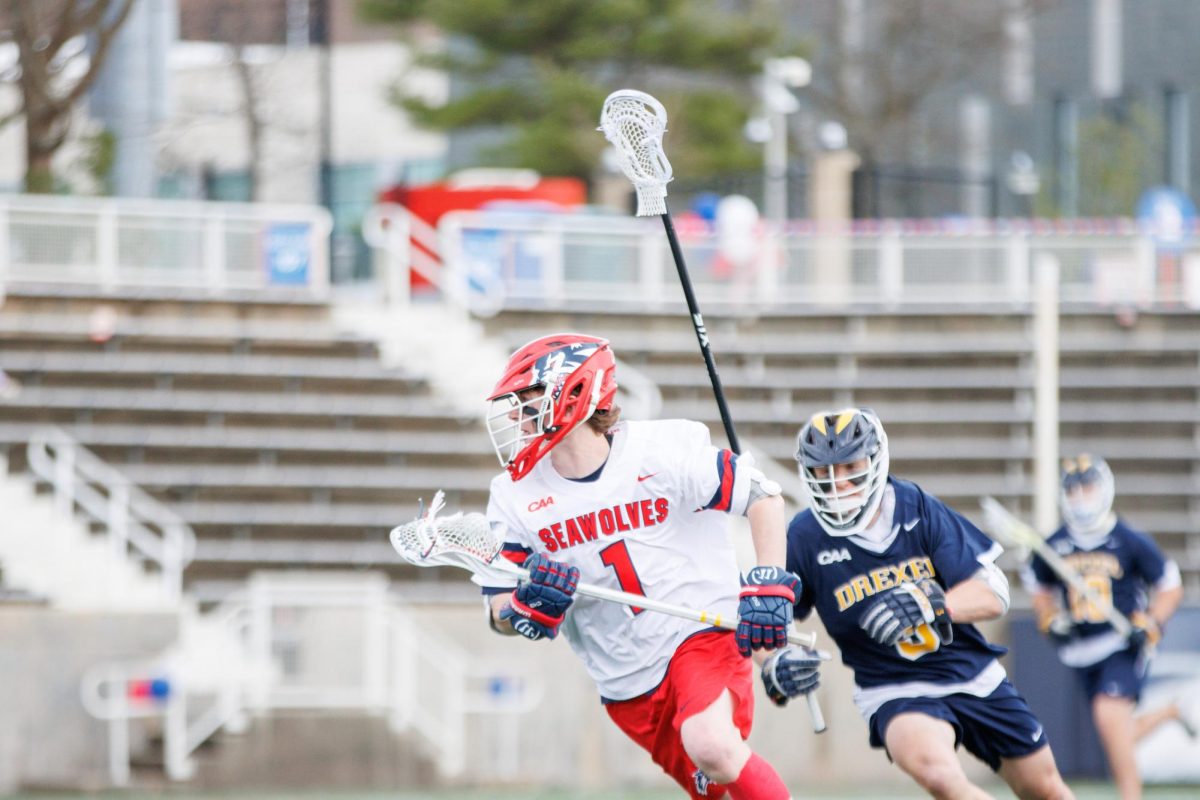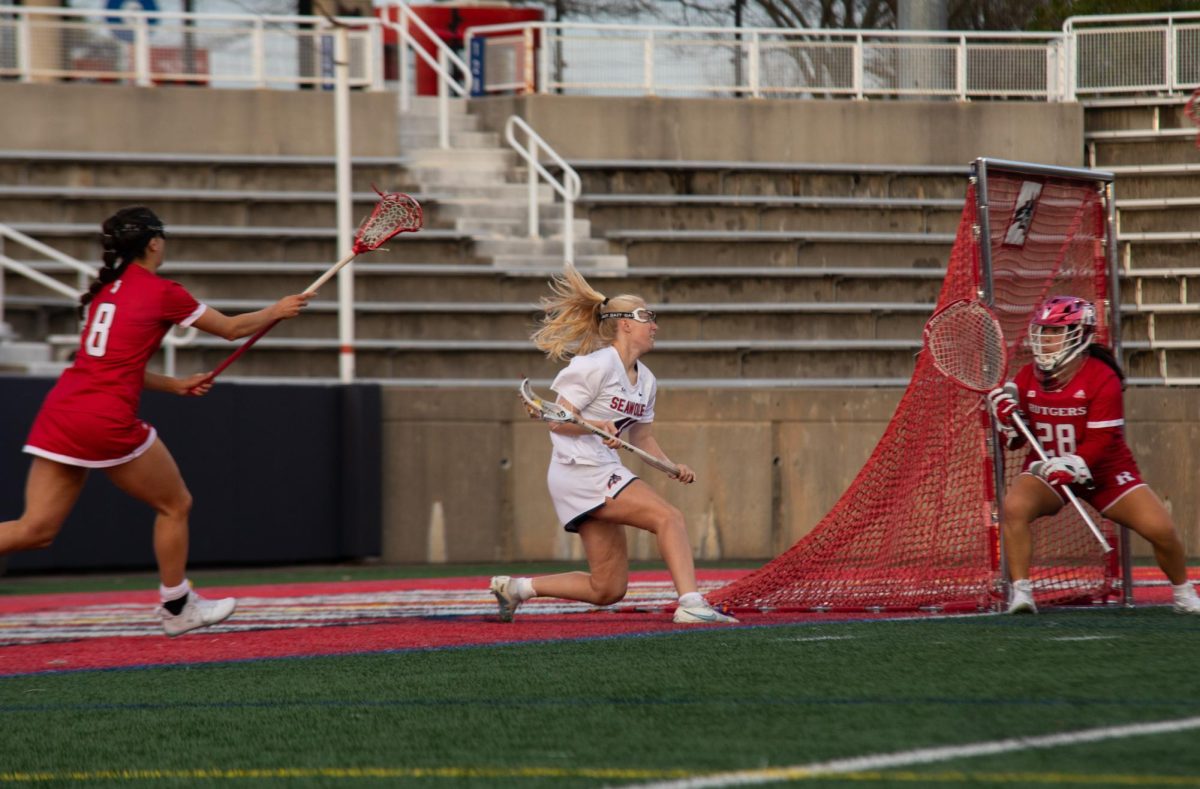Dr. Samuel L. Stanley Jr.: Stony Brook University’s Post-Recession President
Dr. Samuel L. Stanley Jr.
Stony Brook University’s Post-Recession President

WILL WELCH
Timeline of Stanley’s Presidency

WILL WELCH
Early Days
Stanley’s career before coming to Stony Brook was spent at private universities. He earned his undergraduate degree at the University of Chicago and his medical degree at Harvard University Medical School. He worked at Washington University in St. Louis for 26 years, starting as a post-doctoral fellow and rising to the rank of professor.
“I didn’t think it would happen so fast, quite honestly,” Shapiro said.
But the Stony Brook search committee saw Stanley as someone who could bring in funding and advance Stony Brook’s reputation as a research university. As a scientist and a medical doctor, Stanley brought a different perspective to the job than Stony Brook’s previous president, Shirley Strum Kenny, who was an English scholar.
Kenny, who was president from 1994 to 2009, is widely credited with placing Stony Brook on a trajectory to compete with other major research universities. During her presidency, Stony Brook entered a partnership with Battelle Memorial Institute to operate Brookhaven National Laboratory in 1998 and became a member of the Association of American Universities in 2001. Kenny initiated major campus renovation projects and oversaw the expansion of the athletics program into Division I.
Stanley’s mandate was to continue the momentum built during Kenny’s presidency in the face of decreased state funding. Between 2008 and 2010, New York cut $424 million from SUNY’s budget. Like many university presidents, Stanley was asked to do more with less.
Stony Brook University Budget (1998–2016)
Stanley’s predecessor, Shirley Strum Kenny, oversaw a period of rapid growth at the university, often supported by increases in state funding. Despite financial hardships and cuts to the university’s state allocation, Stony Brook’s budget has increased at a similar rate under Stanley’s presidency as it had during Kenny’s presidency.
* Figures not adjusted for inflation
Source: Stony Brook University Budget Office

WILL WELCH
Lean Years
Stanley’s tenure began just one month after Nancy L. Zimpher took office as chancellor of the State University of New York. Throughout the SUNY system, institutions began developing strategic plans and making decisions about how to address budget shortfalls.
In addition to addressing local challenges, Stony Brook and SUNY lobbied the state to pass legislation to offset the effects of budget cuts. In January 2010, Gov. David Paterson introduced the Public Higher Education Empowerment and Innovation Act, supported by SUNY and CUNY, which was the precursor to NYSUNY 2020.
The empowerment act had three major provisions: allowing the boards of trustees for both SUNY and CUNY to raise tuition annually, reducing restrictions on public-private university partnerships and removing purchasing requirements. Although some legislators were willing to consider the last two provisions, which amounted to removing the red tape, changing the tuition policy was a major point of contention.
Until that point, only the legislature had the power to change SUNY’s tuition, which resulted in large infrequent spikes in the cost of tuition when budget pressures demanded it. Since 1963 there had only been 13 tuition increases, the largest of which was a $950 increase to in-state tuition in 2003. When tuition increased, the legislature usually decreased state support, resulting in a shift in the cost of higher education from the state to students.
“If the legislature won’t give us any more money … then they have to let us raise tuition,” said Frederick M. Walter, past president of the University Senate. “You can’t keep both of those down and expect us to be world class.”
Supporters sought a system that would allow the board of trustees to make limited increases to tuition while requiring the state to maintain its level of funding and leave financial aid recipients unharmed. They hoped to use the additional revenue to offset state budget cuts.
Critics, however, anticipated that allowing tuition increases would price some students out of public higher education. The tuition policy SUNY proposed would have also allowed for separate tuition increases at the four university centers, including Stony Brook, which would raise the schools’ price relative to other colleges in the SUNY system.
Ultimately, the empowerment act did not pass with the 2010-11 budget, and SUNY experienced additional cuts. In a message to the university, Stanley estimated a $30 million deficit for Stony Brook. As it became clear that the empowerment act was unlikely to pass, the Stony Brook Foundation launched a nearly $1.2 million lobbying effort in July 2010 to continue to push for a new tuition structure, according to the Times Union, an Albany newspaper.
State vs. Tuition Support of State Purpose at Stony Brook University
New York, like many states, has steadily decreased the funding it provides per student to its public universities over the past few decades. It has increased tuition in turn, shifting the bulk of the cost of education from the state to students. Stony Brook began receiving the majority of its funding for its core instructional budget, also referred to as “state purpose,” from students in the 2011–12 academic year.
* Figures not adjusted for inflation
Source: Stony Brook University Budget Office

WILL WELCH
SUNY 2020
SUNY’s budget problems continued in 2011 when Andrew Cuomo took office as governor. Cuomo proposed budget cuts across the state that would close a $10 billion deficit, including a 10 percent reduction in funding for SUNY and additional cuts for SUNY hospitals. He did, however, include provisions from the empowerment act in his budget enabling public-private partnerships and simplifying procurement.
The donation — the largest in SUNY’s history and the sixth largest to any public university in the country — was announced the same day that Stony Brook’s $35 million Challenge Grant was approved. The combined revenue from the grant and $50 million of the Simons gift was designated for the construction of a $194 million Medical and Research Translation (MART) building.
The MART is by far the largest construction project on Stony Brook’s campus undertaken since Stanley arrived at Stony Brook. The project is scheduled to be completed in 2016, and in many ways is the crowning achievement of Stanley’s presidency so far. It was conceived following important victories for the university after years of crippling budget cuts, demonstrating that the university could grow in even the most hostile climate.
In announcing its SUNY 2020 challenge grant proposal, the university also made plans to invest new tuition revenue in hiring 267 new faculty members and 400 staff, expanding advising services and increasing financial aid. Additional funds from the Simons gift were invested in creating endowed professorships, expanding medical research and supporting graduate students.
Simons’ prior donations to the university of more than $138 million, which stemmed from his success in developing quantitative trading algorithms through his investment firm, Renaissance Technologies, also had the distinction of being the largest in SUNY’s history.
“It’s very fortunate that we have Jim Simons around,” Walter said. “The president has done a very good job with raising consciousness, with fundraising, putting Stony Brook on the map.”
Other private donations, managed by the Stony Brook Foundation, started to pour in following the Simons gift. On Nov. 21, 2015, the university announced that the foundation had raised $426 million since 2011, launching a campaign to raise an additional $176 million by July 2018 for a total of $600 million.
Stony Brook University NYSUNY 2020 Challenge Grant Application
After the passage of NYSUNY 2020, Stony Brook drafted a grant application for $35 million to build a medical and research translation building. It also outlined how it would use funds from the tuition increases allowed under the law.

WILL WELCH
Strategic Planning
As the university became more financially secure, Stanley was able to move past balancing budgets. Initiatives that were announced in 2010 as part of Project 50 Forward began to reach fruition in 2011, setting the stage for a slew of administrative, academic and infrastructure projects across the campus.
Much of the additional support Stony Brook has received from the state has been for economic development projects, including the SUNY 2020 Challenge Grant program and START-UP NY, a program creating tax-free zones on state university campuses to attract new businesses to the state.
“We have a governor now who believes that SUNY’s main reason for existence is to support the economy of the State of New York,” Walter said. “We’re getting away from a mindset that all it’s important to do is to teach people how to think.”
Supporting these programs has been one of the ways Stony Brook and SUNY have made the case for increased investment from the state.
Additionally, fall enrollment in the College of Arts and Sciences dropped by 412 students from 2011 to 2015, compared to an increase of 1,436 students in the College of Engineering and Applied Sciences.
Some faculty members argue that prioritizing STEM fields over other disciplines has weakened the university’s role in providing a liberal arts education. This is a debate taking place at research universities across the country, balancing dual commitments to research and economic impact with a fundamental mission to educate students. That balance often defines the character of institutions, and faculty at Stony Brook argue that arts and humanities should play a key role at the university.
One place that debate has come to a head is in Stony Brook’s branding and marketing materials.
Stanley has launched two major branding initiatives at Stony Brook. The first, in 2012, replaced the logo designed by legendary graphic artist Milton Glaser under Kenny’s presidency with a red shield and new fonts, unifying Stony Brook’s main campus and university hospital brands. The rollout followed the announcement of the Simons gift and funding from SUNY 2020.
The second initiative, launched in 2016, created a series of secondary branding materials designed to focus the university’s messaging to students, faculty, staff, alumni, donors, prospective students and other universities with the slogan “Far Beyond.” It followed the announcement of Stony Brook’s $600 million fundraising effort.
“Far Beyond” identified STEM and medicine, value, diversity, stewardship and momentum as brand pillars, drawing the attention of faculty who noted almost no mention of Stony Brook’s strengths in the arts and humanities.
“There is tremendous focus on STEM fields, to the neglect of humanities, arts and social sciences,” said Norman Goodman, a SUNY senator and sociology professor who has taught at Stony Brook for more than 50 years. “The core value of what makes Stony Brook Stony Brook is research. But there is research in the arts and humanities and there is research in social sciences as well as STEM fields.”
Vice President for Communications Nicholas Scibetta, who was hired in January 2015 to retool the university’s marketing strategy, said the campaign would eventually incorporate messaging from the humanities. But the omission had already signaled to some faculty members that arts and humanities are not important to the administration’s strategy.
Selected Fall Enrollment at Stony Brook University
Source: Stony Brook University Office of Institutional Research, Planning & Effectiveness

WILL WELCH
Stanley and the University Senate
Stanley argued that he could not be limited to the Senate’s suggestions, but Goodman said this issue demonstrated Stanley’s lack of willingness to work with the governance body.
“There seems to be less of an understanding of the importance of shared governance — an understanding and respect for the elected members of the governance body and their views,” Goodman said.
Although Stanley answered several questions over email, he declined to be interviewed for this story.
People who have worked with Stanley in the Senate say his leadership has improved. He is better at talking with faculty members and handling sometimes tense meetings. Faculty members also appreciate the administrators Stanley has hired to senior leadership positions, including Provost Dennis Assanis, who was appointed in 2011 and is leaving Stony Brook to become the next president of the University of Delaware in July.
Despite their complaints about his leadership style, members of the University Senate agree Stanley has moved the university forward.
“If I were given the choice between someone who was not an effective leader and someone who is incredibly consultative, I would choose the effective leader who is getting us places,” Schedel said. “Overall, I think he’s doing a great job.”
Despite financial hardships, Stony Brook’s budget has increased at a similar rate under Stanley’s presidency as it had during Kenny’s presidency. Stony Brook’s budget was $2.6 billion during the 2015–2016 academic year.

WILL WELCH
2016 and Beyond
Despite the university’s successes, Stony Brook still faces considerable challenges with state funding. Since the passage of SUNY 2020, the state has made no effort to roll back recession-era cuts to SUNY’s operating budget.
“In the six-and-a-half years I’ve been here, there has not ever been a significant increase in state allocation,” Stanley said at a meeting with student reporters.
Additionally, although SUNY was protected from direct cuts through the maintenance of effort language in SUNY 2020, state-negotiated contractual salary increases have raised operating costs. Last year, with $1 million in one-time funding from the state to offset costs, the university was left with an $8 million budget gap. This year the total gap is approximately $15.7 million.
In 2015, the legislature passed a new maintenance of effort bill that would include the costs of salary increases and utilities. The bill received near-unanimous support in the Assembly and Senate, but it was vetoed by the governor on Dec. 11. In his veto memo, Cuomo wrote “… the issues raised by this legislation are better dealt with in the context of negotiations for the upcoming State budget.”
As the end of the five-year tuition and maintenance of effort provisions of SUNY 2020 approached in 2016, SUNY and Stony Brook began to push for an extension of law.
Members of the Undergraduate Student Government passed a resolution in February 2015 supporting an extension and visited Albany to talk to legislators. They did the same again in 2016. Stanley made multiple visits to Albany and Stony Brook marketed its accomplishments under the law.
The university also asked for additional critical maintenance funds to make repairs to buildings that desperately need attention. Stony Brook used to receive approximately $75 million annually in critical maintenance dollars, but that allocation was eliminated in 2013 and restored to only $27 million in 2014.
Greiman was cautiously optimistic at a University Senate meeting on March 7. Cuomo had included SUNY 2020 in his executive budget, and his support gave the extension a good chance of passing.
“Legislators understand that we can’t end up with what I call a perfect storm,” Greiman said. “We can’t walk out of this session with no tuition increase, no payment of salary and no base funding increase.”
But the perfect storm came on April 1. SUNY lost its ability to raise tuition without receiving any increases to its operating budget. The legislature did not renew maintenance of effort and made no increases to cover rising salary costs or critical maintenance.
Stanley has said that he wants Stony Brook to stand among the top 20 public universities in the country, but competing for students, faculty and research funding requires money.
“We are not going to reach that goal unless we raise more money than we are raising currently,” Stanley said. “It would be helpful to have a little more money from the state to reach that goal as well, but I will work with what I have.”
Over the past few decades, states across the country have shifted many of the costs of public higher education to students. At Stony Brook, tuition revenue outpaced state support for the university’s state-defined operations for the first time in the 2011-12 academic year. Legislators froze tuition in 2016 to keep higher education in New York affordable, but by not increasing state support they also limited the quality of education New York can provide.
Stanley’s presidency at Stony Brook has been defined by his ability to support the growth of the university through philanthropy, strategic investment and increasing tuition. The future of his presidency will hinge on whether those resources alone will be enough.
Will Welch, ’16, is the former web and graphics editor of The Statesman. He produced this story as a part of his capstone project for the Stony Brook University School of Journalism’s bachelor degree program. The Statesman has republished the story with his permission.







